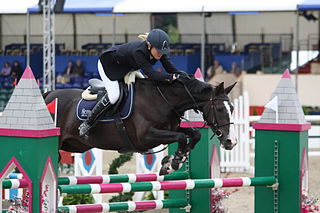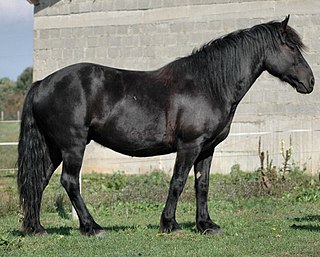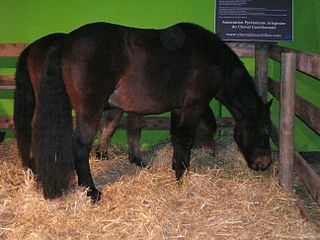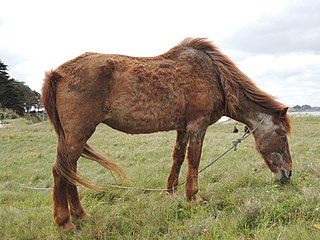
The Selle Français (SF) is a breed of sport horse from France. It is renowned primarily for its success in show jumping, but many have also been successful in dressage and eventing. An athletic horse with good gaits, it is usually bay or chestnut in color. The Selle Français was created in 1958 when several French riding horse breeds were merged into one stud book. The new breed was meant to serve as a unified sport horse during a period when horses were being replaced by mechanization and were transforming into an animal used mainly for sport and leisure.

The Boulonnais, also known as the "White Marble Horse", is a draft horse breed. It is known for its large but elegant appearance and is usually gray, although chestnut and black are also allowed by the French breed registry. Originally there were several sub-types, but they were crossbred until only one is seen today. The breed's origins trace to a period before the Crusades and, during the 17th century, Spanish Barb, Arabian, and Andalusian blood were added to create the modern type.

The Auxois is a horse breed from eastern France. It is a large breed, with some individuals weighing over 910 kilograms (2,010 lb), bred for horse meat, agricultural work and leisure pursuits. Overall, members of the breed are solid and muscular in appearance. They are usually bay or bay roan in color, although some other colors are accepted by the breed registry, and are known for their power and docility.

The Trait du Nord, previously also known as Ardennais du Nord or Ardennais de type Nord, is a breed of heavy draft horse developed and bred in the area of Hainaut in western Belgium and in northeastern France. Originally considered a subtype of the Ardennes, it was recognized as an individual breed with the opening of a studbook in 1903. Developed in the fertile Flemish grasslands, it was bred for size and pulling power for agricultural work. By 1855, the horses bred near Hainaut were considered by some veterinarians to be superior to other Flemish draft breeds. The Trait du Nord was used extensively in mining from the late 19th century through 1920, with lesser use continuing through the 1960s.

The Landais is a critically-endangered French breed of small horse or pony. It originated in the marshy plains and woodlands of the département of the Landes, in the Nouvelle-Aquitaine region of south-western France, but is more often reared in the département of Pyrénées-Atlantiques, particularly in the arrondissement of Pau. Due to influences from Arab and Welsh blood, it shows more similarity to Oriental horses than to other Celtic breeds. It is used for riding and driving, and is a good trotter.

The Mérens, Cheval de Mérens or Caballo de Merens, still occasionally referred to by the older name of Ariégeois pony, is a small, rustic horse native to the Pyrenees and Ariégeois mountains of southern France, where the river Ariège flows, and northern Spain, near Andorra. Two general types, a small, light traditional mountain horse and a taller, sportier modern type, are found. Always black in color, Mérens must meet strict physical standards in order to be registered in the stud book. The breed is known for its sure-footedness on mountain terrain, as well as for its endurance, hardiness and docility. The French breed registry organizes regional offices, and partners with other national organizations in Europe to preserve and promote the breed. The organization enforces rigorous selection of breeding stock, with a goal of increasing quality in the breed. In the past, the Mérens was used for farm work, draft work and as pack horses. Today it is mainly used as a saddle horse, although some members of the breed have been successful in carriage driving. Many Mérens are taken on an annual transhumance, in which they are moved higher in the mountains during the summer and into the valleys for the winter. An old practice, it fell into disfavor, but has recently re-emerged.

The Poitevin or Poitou is a French breed of draft horse. It is named for its area of origin, the former province of Poitou in west-central France, now a part of the region of Nouvelle-Aquitaine. It was formed in the seventeenth century when horses of Flemish or Dutch origin, brought to the area by engineers working to drain the Marais Poitevin, interbred with local horses. Although it has the size and conformation of a draft horse, the Poitevin has never been bred for draft abilities, and has been little used for draft work. Its principal traditional use was the production of mules. Poitevin mares were put to jacks of the large Baudet du Poitou breed of donkey; the resulting Poitevin mules were in demand for agricultural and other work in many parts of the world, including Russia and the United States. In the early twentieth century there were some 50,000 brood mares producing between 18,000 and 20,000 mules per year.

The Anglo-Norman horse is a warmblood horse breed developed in Lower Normandy in northern France. A major center of horse breeding, the area had numerous regional types that were bred to one another and then crossed with Thoroughbreds to form the Anglo-Norman. Various body types developed within the Anglo-Norman breed, two of which were split off to form the Norman Cob and French Trotter. The remaining types were eventually standardized, although there remained some criticism of the "hybrid" nature of the breed's conformation. However, it is successful as an international sport horse, especially in the sport of show jumping. The Anglo-Norman also contributed to the development of several other breeds in Europe and Asia.

The Castillonais or Cheval Ariègeois de Castillon , also formerly called Cheval du Biros or Saint-Gironnais, is an ancient breed of small rustic saddle-horse from the Ariège département of south-western France. It may be dark bay or seal brown. It stands 135–155 centimetres at the withers, with an average height of about 145 cm. It is used principally for trekking and for driving.

The Charolais or Charollais is an extinct breed of warmblood horse from the Charolais, the country lying around the town of Charolles, now in the Saône-et-Loire département of Burgundy, in eastern central France. Like other French warmbloods, it was the result of crossing local agricultural horses with the Thoroughbred, and was known by the name of the region without ever having a specific stud-book. Like other French warmbloods including the Angevin, the Charentais, the Cheval Limousin and the Vendéen, it was fused with the Anglo-Normand in 1958 in order to create the national warmblood stud-book, the Selle français. It was originally used as a multi-purpose horse for riding, driving, and agriculture. During the late 19th century, additional Thoroughbred blood was added and a new type emerged that was principally used as a light cavalry mount. It was also used for dressage and show jumping.

The Norman Cob or Cob Normand is a breed of light draught horse that originated in the region of Normandy in northern France. It is of medium size, with a range of heights and weights, due to selective breeding for a wide range of uses. Its conformation is similar to a robust Thoroughbred, and it more closely resembles a Thoroughbred cross than other French draught breeds. The breed is known for its lively, long-striding trot. Common colours include chestnut, bay and seal brown. There are three general subsets within the breed: horses used under saddle, those used in harness, and those destined for meat production. It is popular for recreational and competitive driving, representing France internationally in the latter, and is also used for several riding disciplines.

The Henson Horse, or Cheval de Henson, is a modern horse breed from northeast France. It was created by the selective breeding of light saddle horses with the smaller, heavier Norwegian Fjord horse to create small horses suitable for the equestrian vacation industry. The breeders' association, Association du Cheval Henson, was formed in 1983. In 1995 the studbook was closed to horses not born from Henson parents, and in 2003 the breed was officially recognised by the French government agencies for horse breeding. A hardy breed of horse, each winter the broodmares and youngstock from several breeders are let loose together to graze freely in the wetland reserves in France.

The Charentais and Vendéen are extinct breeds of horse from western France. They were bred principally in the area around Poitou-Charentes and Vendée, France. They were used as a mount for light cavalry.

The Bidet was a type of small horse from France, now extinct. It was a landrace developed principally in the area around Brittany, Morvan, Auvergne, Poitou, and Burgundy. It stood about 110–135 centimetres at the withers. Two distinct groups are documented, which were bred in a semi-feral state.

Marine Oussedik, born on May 20, 1967, is a painter, sculptor and an illustrator specialized in horses. In 1990, she graduated from ESAG Penninghen, the Higher College of Graphic Arts, and started exhibiting in Parisian galleries the following year. Immediately afterwards she was commissioned paintings by the Living Museum of the Horse in Chantilly to be permanently displayed in two rooms. At the same time she published a book, Les chevaux d'encre. Many art books would follow including Les chevaux du Sahara in 1998, Les chevaux du vent in 2002 and Les chevaux de rois in 2003. She would be rewarded by Prix Pégase for those last two books which testify to her passion for illustrations of all kind of horses, Arabians being her favorite. In 2014, she illustrated an art book dedicated to classical French riding with texts by Guillaume Henry.

Laetitia du Couëdic de Kerérant is a Franco-Swiss equestrian rider. Her specialty is show jumping, either individually or as part of a team. She was Swiss junior champion in Lugano Switzerland in August 2013, a month after she won a gold medal at The European championship at Vejer de la Frontera Spain. Laetitia du Couëdic started her official CSI programme in 2015 at the CSI5* in Zurich riding Elisa followed by Cagnes-sur-mer France on her recently acquired Cheyenne 111 Z HDC. In October 2013, she won the Grand Prix U25 CSI at Chevenez (JU) and was a wild card entry for the CHI Geneva in Geneva where she was the youngest rider. Laetitia du Couëdic is ambassador of Hermès, the French Luxury goods maker. She is also an ambassador of JustWorld international, a charity project. In 2017 she won the Fontainebleau Grand Prix (CSIOY - Fontainebleau and was Bronze medal at Swiss championships. Laetitia has been selected for the Swiss team competing at the European Championships in Samorin where she ranked 17th. She rides regularly the "Saut Hermès" in Paris, The Rolex Grand-Prix in Geneva.

A hot-blooded horse is a term from the field of horse breeding, coined by orientalists and popularized by various hippologists. It refers to a light horse with a lively temperament, belonging to a breed of North Africa, the Near East and Central Asia. Such a name is also applied to the descendants of horses from these geographical regions, this vague concept includes many breeds of horses from a wide variety of countries, such as the Thoroughbred, but also the Anglo-Arabian, the and the Namib horse. The Caspian, originating in northern Iran, is believed to be the oldest known hot-blooded breed.

Haguard horse, also known as the Hague pony or bidet de la Hague, is a breed of bidet horse native to the natural region of La Hague, in the Manche in Normandy.

A geriatric horse is an equine that has a physical and mental decline, which generally prevents it from being used for most equestrian activities. The age of a geriatric horse could vary according to breed and riding use, with old age occurring more rapidly in Thoroughbred sport horses than in hardy ponies. Geriatric horse signs include tooth eruption, whitening of certain areas of the head, arching of the back and stiffness of locomotion. The animal also becomes more sensitive to the passing of the seasons.

The Barraquand horse is a French mountain horse breed. It is the result of an ancient selection process in the Vercors massif, and it may have originated from a small herd of animals selected by religious communities, notably those established in the Léoncel abbey. It takes its name from the Barraquand family, who developed their breeding from the late 19th century to the 1950s, thanks to the practice of transhumance. Considered lost after the bankruptcy of the original Barraquand breeding operation and the sale of part of their land in 1963, the breed has been reconstituted since the 1990s, thanks to the initiative of several breeders and local institutions, in particular the Barraquand family, the Vercors Regional Natural Park and the Annecy National Stud.




















